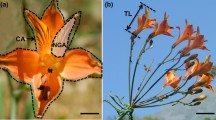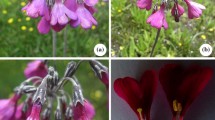Abstract
Floral integration may result from the combined effects of pollinator-mediated selection, genetic correlations and abiotic factors. Thus, by sampling a set of populations in the field and examining their variation of floral correlations in relation to pollinators and abiotic factors, we intended to shed light on the ecological factors underlying the evolution of floral integration. In this study, floral integration patterns and the composition of pollinator assemblage were characterized across ten populations of Alstroemeria ligtu to test the following: (1) Whether the patterns of floral integration estimated at population level covary with the composition of local pollinator assemblage, climate and/or geographic distance. (2) Whether the magnitude of floral integration decreases with the number or the morphological variability of pollinators. (3) Whether the behavior of the three most widespread pollinators is affected by floral integration. Our results indicated that populations with similar patterns of integration showed greater similitude in pollinator assemblages, but that this was not related to climate or geographic distance. We also found that the most widespread pollinator, Centris nigerrima, invested lower handling time in populations with higher levels of floral integration. The magnitude of floral integration was not related to taxonomical diversity, yet, unexpectedly, correlated positively with the variability of pollinator proboscis length. We suggest that variation in the magnitude and pattern of floral integration across the species range was related to the composition of pollinator assemblage, and not to pollinator diversity per se, nor to climatic variables. A. ligtu was visited by numerous pollinators, but floral integration patterns are likely shaped by only a subset of them, such as C. nigerrima, which is sensitive to variations in floral architecture.


Similar content being viewed by others
References
Anderson IA, Busch JW (2006) Relaxed pollinator-mediated selection weakens floral integration in self-compatible taxa of Leavenworthia (Brassicaceae). Am J Bot 93(6):860–867
Armbruster WS, di Stilio VS, Tuxill JD, Flores C, Velásquez JL (1999) Covariance and decoupling of floral and vegetative traits in nine neotropical plants: a re-evaluation of Bergs’ correlation pleides concept. Am J Bot 86:39–55
Armbruster WS, Pélabon C, Hansen TF, Mulder CPH (2004) Floral integration, modularity, and accuracy: distinguishing complex adaptations from genetic constraints. In: Pigliucci M, Preston K (eds) Phenotypic integration: studying the ecology and evolution of complex phenotypes. Oxford University Press, New York, pp 23–49
Armbruster WS, Pélabon C, Bilstad GH, Hansen TF (2014) Integrated phenotypes: understanding trait covariation in plants and animals. Philos Trans R Soc B 369. doi:10.1098/rstb.2013.0245
Arroyo MT, Uslar P (1993) Breeding system in a temperate Mediterranean-type climate montane sclerophyllous forest in central Chile. Bot J Linn Soc 111:83–102
Berg RL (1960) The ecological significance of correlation pleides. Evolution 14:171–180
Bissell EK, Diggle PK (2008) Floral morphology in Nicotiana: architectural and temporal effects on phenotypic integration. Int J Plant Sci 169:225–240
Botto-Mahan C, Ojeda-Camacho M (2000) The importance of floral damage for pollinator visitation in Alstroemeria ligtu L. Rev Chil Entomol 26:73–76
Botto-Mahan C, Ramírez PA, Ossa CG, Medel R, Ojeda-Camacho M, González AV (2011) The functional role of flower nectar guides in the perennial herb Alstroemeria ligtu (Alstroemeriaceae). Int J Plant Sci 172:1130–1136
Brock MT, Weinig C (2007) Plasticity and environment-specific covariances: an investigation of floral–vegetative and within flower correlations. Evolution 61(12):2913–2924
Brock MT, Dechaine JM, Iniguez-Luy FL, Maloof JN, Stinchcombe JR, Weinig C (2010) Floral genetic architecture: an examination of QTL architecture underlying floral (co) variation across environments. Genetics 186(4):1451–1465
Caruso CM, Peterson SB, Ridley CE (2003) Natural selection on floral traits of Lobelia (Lobeliaceae): spatial and temporal variation. Am J Bot 90:1333–1340
Cheverud JM (1982) Phenotypic, genetic, and environmental morphological integration in the Cranium. Evolution 36:499–516
Cheverud JM, Wagner GP, Dow MM (1989) Methods for the comparative analysis of variation patterns. Syst Zool 38:201–213
Conner JK (1997) Floral evolution in wild radish: the roles of pollinators, natural selection, and genetic correlations among traits. Int J Plant Sci 158:S108–S120
Conner JK, Via S (1993) Pattern of phenotypic and genetic correlations among morphological and life-history traits in wild radish, Raphanus raphanistrum. Evolution 47:704–711
Cosacov A, Cocucci AA, Sersic AN (2014) Geographical differentiation in floral traits across the distribution range of the Patagonian oil-secreting Calceolaria polyrhiza: do pollinators matter? Ann Bot 113:251–266
Diggle P (2014) Modularity and intra-floral integration in metameric organisms: plants are more that the sum of their parts. Philos Trans R Soc B 369. doi:10.1098/rstb.2013.0253
Ellis AG, Johnson SD (2009) The evolution of floral variation without pollinator shifts in Gorteria diffusa (Asteraceae). Am J Bot 96:793–801
Galen C (1999) Why do flowers vary? The functional ecology of variation in flower size and form within natural plant populations. Bioscience 49:631–640
Gómez JM, Perfectti F, Klingenberg CP (2014) The role of pollinator diversity in the evolution of corolla-shape integration in a pollination-generalist plant clade. Philos Trans R Soc B 369. doi:10.1098/rstb.2013.0257
González AV, Murúa M, Ramírez P (2014) Spatial and temporal variation in the pollinator assemblages of Alstroemeria ligtu (Alstroemeriaceae). Rev Chil Hist Nat. doi:10.1186/0717-6317-1-5
Hammer O, Harper D, An PRY (2001) PAST: paleontological statistics software for education and data analysis. Paleontol Electrón 4:1–9
Herrera CM, Cerda X, García MB, Guitián J, Medrano M, Rey PJ, Sánchez-Lafuente AM (2002) Floral integration, phenotypic covariance structure and pollinator variation in bumblebee-pollinated Helleborus foetidus. J Evol Biol 15:108–121
Herrera CM, Castellanos MC, Medrano M (2006) Geographical context of floral evolution: towards an improved research programme in floral diversification. In: Harder LD, Barrett SCH (eds) Ecology and evolution of flowers. Oxford University Press, USA, pp 278–294
Leonard AS, Papaj DR (2011) ‘X’ marks the spot: the possible benefits of nectar guide to bees and plants. Funct Ecol 25:1293–1301
Murren C (2002) Phenotypic integration in plants. Plant Spec Biol 17:89–99
Nattero J, Sérsic AN, Cocucci AA (2010) Patterns of contemporary phenotypic selection and flower integration in the hummingbird-pollinated Nicotiana glauca between populations with different flower-pollinator combinations. Oikos 119:852–863
Ohashi K (2002) Consequences of floral complexity for bumblebee-mediated geitonogamous self-pollination in Salvia nipponica Miq. (Labiatae). Evolution 56:2414–2423
Ordano M, Fornoni J, Borge K, Domínguez CA (2008) The adaptive value of phenotypic floral integration. New Phytol 179:1183–1192
Pérez- Barrales R, Simón-Porcar VI, Santos-Gally R, Arroyo J (2014) Phenotypic integration in style dimorphic daffodils (Narcissus, Amaryllidaceae) with different pollinators. Philos Trans R Soc B 369. doi:10.1098/rstb.2013.0258
Pérez F, Arroyo MTK, Medel R (2007) Phylogenetic analysis of floral integration in Schizanthus (Solanaceae): does pollination truly integrate corolla traits? J Evol Biol 20:1730–1738
Pérez-Barrales R, Arroyo J, Armbruster WS (2007) Differences in pollinator faunas may generate geographic differences in floral morphology and integration in Narcissus papyraceus (Amaryllidaceae). Oikos 116:1904–1918
Pigliucci M (2003) Phenotypic integration: studying the ecology and evolution of complex phenotypes. Ecol Lett 6:265–272
Pigliucci M, Preston K (2004) Phenotypic integration, studying the ecology and evolution of complex phenotypes. Oxford University Press, New York
R Development core team (2013) R: a language and environment for statistical computing. R Foundation for Statistical Computing, Vienna
Rosas-Guerrero V, Quesada M, Armbruster WS, Pérez-Barrales R, DeWitt S (2010) Influence of pollination specialization and breeding system on floral integration and phenotypic variation in Ipomoea. Evolution 65–2:350–364
Schemske D, Brokaw N (1981) Tree falls and the distribution of understory birds in a tropical forest. Ecology 62:938–945
Stebbins GL (1974) Flowering plants: evolution above the species level. Harvard University Press, Cambridge
Ushimaru A, Kikuchi S, Yonekura R, Maruyama A, Yanagisawa N, Kagami M, Nakagawa M, Mohoro S, Kohmatsu Y, Hatada A, Kitamura S, Nakata K (2006) The influence of floral symmetry and pollination systems on flower size variation. Nor J Bot 24:593–598
Wagner GP (1984) On the eigenvalue distribution of genetic and phenotypic dispersion matrices: evidence for a nonrandom organization of quantitative character variation. J Math Biol 21:77–95
Waitt DE, Levin DA (1993) Phenotypic integration and plastic correlations in Phlox drummondii (Polemoniaceae). A J Bot 80:1224–1233
Acknowledgments
The authors would like to thank L. Carrasco, M. Zúñiga, P. Salinas, V. Durán, T. Poch, M.J. Ramírez, and D. Lillo for their help during the fieldwork; S. Poch for providing the artwork of A. ligtu simsii (Fig. 1a); and F. Fontúrbel for his statistical analysis support. We thank to valuable comments and suggestions by the associate editor (J. M. Gómez) and two anonymous reviewers. Financial backing for this study was obtained from Fondecyt 11110120 to A.G, and ICM P05-002, the Millennium Institute of Ecology and Biodiversity (IEB), Grant P05-002 from Mideplan, PFB 23 from Conicyt to FP. We are grateful to the Corporación Nacional Forestal (CONAF) and Jardín Botánico Nacional of Chile for granting permits to work on their estate.
Author information
Authors and Affiliations
Corresponding author
Electronic supplementary material
Below is the link to the electronic supplementary material.
Rights and permissions
About this article
Cite this article
González, A.V., Murúa, M.M. & Pérez, F. Floral integration and pollinator diversity in the generalized plant-pollinator system of Alstroemeria ligtu (Alstroemeriaceae). Evol Ecol 29, 63–75 (2015). https://doi.org/10.1007/s10682-014-9746-3
Received:
Accepted:
Published:
Issue Date:
DOI: https://doi.org/10.1007/s10682-014-9746-3




